
|
Greatest Films (of the 20th Century) Summaries - Part 3 |
|
The
Third Hundred Greatest Films (of the 20th Century) Summaries - Part 3 (Links to Comprehensive Film Reviews) Selection Criteria |
F |
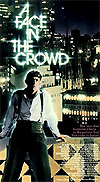 A Face in the Crowd (1957) A Face in the Crowd (1957)Starring: Andy Griffith, Patricia Neal, Walter Matthau, Lee Remick Director: Elia Kazan Director Elia Kazan's powerful and satirical political drama illustrated how a jailed, down-home country boy in the late 1950s could be transformed overnight into a media celebrity on the radio, and later become a mean-spirited political demagogue and megalomaniac on TV. In the opening sequence, Larry "Lonesome" Rhodes (Andy Griffith in his film debut) - an opportunistic, smiling, drunken cornpone-spouting, back country homeless man, was first heard strumming his bluesy guitar in a rural jail-cell, in the fictional town of Pickett in northeast Arkansas. He had been taken in the previous night for being "drunk and disorderly." KGRK radio reporter/producer Marcia Jeffries (Neal) conducted her local radio show ("A Face in the Crowd") from the cell and became transfixed when she heard him sing the home-spun song "Free Man in the Morning." Afterwards, Rhodes was brought to Memphis, Tennessee to appear on TV, and introduced to bookish, well-educated staff writer Mel Miller (Walter Matthau). Soon, the new con-artist/star would be making commercial pitches in New York for a product known as Vitajex - a dietary supplement to increase energy and sexual virility. In a revealing scene with Marcia, Rhodes revealed his disturbing, arrogant and power-hungry intentions that his audience would sheepishly follow him anywhere, and be directed to wherever he wished: ("They're mine. I own 'em. They think like I do. Only they're even more stupid than I am, so I gotta think for 'em. Marcia, you just wait and see. I'm gonna be the power behind the President, and you'll be the power behind me. You made me, Marcia. You made me. I always say that. I owe it all to you. I owe it all to you."). In a side story, although Rhodes proposed marriage to Marcia, he became infatuated with teenaged, 17 year-old baton twirler Betty Lou Fleckum (Lee Remick in her screen debut), and eloped with her, and engaged in a 50-50 business partnership with Marcia. On a number of occasions, Rhodes expressed how disrespectful, fraudulent and hypocritical he was. When concluding his national TV show ("The Cracker Barrel"), thinking that his microphone had been cut off (but was deliberately turned back on by Marcia to expose his duplicity), he showed his utter contempt for his mass audience by personally and nastily insulting them as stupid morons. In the stunning conclusion of his inevitable melt-down and spectacular downfall, drunken and delusional rabble-rouser Rhodes was in his swanky hotel two-floor penthouse for a fancy dinner party of political elites, to advance his own political agenda, where he found an empty room attended only by black butlers and servants, and he threatened to commit suicide after being disowned by his previous adoring public. Although Rhodes was finished for the time being, Miller predicted that it might only be a temporary setback. |
 Field
of Dreams (1989) Field
of Dreams (1989)Starring: Kevin Costner, James Earl Jones, Amy Madigan, Ray Liotta, Gaby Hoffmann, Timothy Busfield, Burt Lancaster Director: Phil Alden Robinson Just one year after playing catcher "Crash" Davis in Bull Durham (1988), Kevin Costner appeared in this - another baseball-themed film coupled with the religious themes of faith and redemption. This sentimental, modern fantasy classic became a smash hit in its unique depiction of Americana. Idealistic Ray Kinsella (Costner), a transplanted city boy-turned-Iowa corn farmer, hears a ghostly Voice telling him to build a baseball diamond in the middle of his corn field, to "ease his pain." His wife Annie (Madigan) is semi-supportive but worried about their finances if he plowed down his crops. No one but those who believe can see the ghostly ballplayers who begin to appear. This Capra-esque film recalls Harvey (1950), a film in which its main character (James Stewart) believes he is befriended by a giant 6-foot rabbit that no one can see. (Ray's daughter Karin (Hoffmann) is watching Harvey on T.V. at one point in the film, to emphasize the connection.) Adapted from W. P. Kinsella's novel Shoeless Joe, the film is almost dreamlike (aided by the mystical score by James Horner), as Ray meets with various sad and wistful icons, including the ghost of Shoeless Joe Jackson (Liotta) who was banned from baseball for life after the 1919 Black Sox scandal, a disillusioned, reclusive J.D. Salinger-like writer in Boston named Terence Mann (Jones), and a small-town doctor named Doc "Moonlight" Graham (Lancaster) - a rookie player who years earlier yearned to make it into the major leagues. The film reaches its climax with Mann's famous monologue on the place of baseball in American history: "The one constant through all the years, Ray, has been baseball. America has rolled by like an army of steamrollers. It's been erased like a blackboard, rebuilt, and erased again. But baseball has marked the time. This field, this game, is a part of our past, Ray. It reminds us of all that once was good, and that could be again. Oh people will come, Ray. People will most definitely come." Academy Award Nominations: 3, including Best Picture, Best Adapted Screenplay--Phil Alden Robinson, Best Score--James Horner. |
 A
Fish Called Wanda (1988) A
Fish Called Wanda (1988)Starring: John Cleese, Jamie Lee Curtis, Kevin Kline, Michael Palin Director: Charles Crichton One of the cleverest, quirkiest and wittiest madcap caper comedies ever made, that included members of the original anarchic Monty Python troupe with American stars - in a subversive and raucous tale that combined both British and American humor. The film recalls the British Ealing Studio comedies (such as Crichton's own The Lavender Hill Mob (1951) and The Ladykillers (1955)) and Preston Sturges' The Lady Eve (1941). As the tagline stated, the unexpected hit was "a tale of murder, lust, greed, revenge, and seafood," in which three eccentric thieves (Curtis, Kline, and Palin) battle the authorities and each other to recover a valuable cache of stolen diamonds. All actors are perfect in their roles, especially the self-absorbed, not-too-bright ("Don't you ever call me stupid") Buddha-misquoting Anglophobe Otto West (Kline) and the stuttering, animal-loving hitman Ken (Palin). Features such bits as Ken's attempts at murdering an old woman that results in the deaths of her dogs (to his horror), Otto's constant tormenting of Ken ("Look! It's K-k-ken coming to k-k-kill me!") and conservative, uptight barrister Archie Leach (Cleese), Wanda Gerschwitz's (Curtis) use of sex to dominate the men in her life and her total arousal to foreign languages like Italian and Russian. The leads would team up again in the comedy Fierce Creatures (1997), in lieu of a sequel. Academy Award Nominations: 3, including Best Director--Charles Crichton, Best Original Screenplay--John Cleese, Charles Crichton. Academy Awards, 1: Best Supporting Actor--Kevin Kline. |
 Footlight
Parade (1933) Footlight
Parade (1933)Starring: James Cagney, Joan Blondell, Ruby Keeler, Dick Powell, Guy Kibbee Director: Lloyd Bacon One of the three most spectacular musicals in 1933 from Warner Bros. and legendary choreographer Busby Berkeley, alongside 42nd Street (1933) and Gold Diggers of 1933 (1933) - with this entry often considered the best of all three. The film is also notable for its suggestive pre-Hays Code dialogue and scenes. It stars James Cagney in his first, big singing-and-dancing musical role as unemployed yet enterprising Broadway musical-theatrical producer Chester Kent, with Joan Blondell as his loyal and dedicated secretary Nan Prescott. Its familiar plot, a backstage tale about putting on a lavish show, revolves around the production of live music numbers (called "prologues") for movie theatres to present before features, to give stage performers work who had been rendered unemployed by the advent of the "talkies." The thin plot is basically an excuse to show off the elaborate and extravagant Berkeley production numbers, especially the three showstoppers at the end of the film: "Honeymoon Hotel," "By a Waterfall" with gorgeous bathing beauties, and "Shanghai Lil" (providing commentary on Paramount's Shanghai Lily character (Marlene Dietrich in Shanghai Express (1932) from the year before)). Cagney's varied career featured him in both tough guy roles, such as Tom Powers in Public Enemy (1931) and Cody Jarrett in White Heat (1949), as well as in song-and-dance roles such as this one - and perhaps his most famous musical role as real-life Broadway impresario George M. Cohan in Yankee Doodle Dandy (1942). No Academy Award Nominations. |
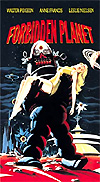 Forbidden Planet (1956) Forbidden Planet (1956)Starring: Leslie Nielsen, Walter Pidgeon, Anne Francis, Marvin Miller (voice) Director: Fred Wilcox This influential, classic science-fiction space adventure - the first science-fiction film in color and CinemaScope - and an adaptation of Shakespeare's The Tempest - was a forerunner of the entire Star Trek (and Lost in Space) franchises. The story, set in the 23rd century AD, told of a journey by astronauts, led by Commander Adams (Nielsen) on a flying saucer-shaped United Planets space cruiser C-57D to a distant planet-star named Altair-IV with green skies, to investigate the fate of a colony (the Bellerophon expedition) planted about 20 years earlier. Upon their arrival, they met the sole surviving crew member - reclusive philologist Dr. Edward Morbius (Walter Pidgeon as Prospero) - and his lovely, doe-eyed and very naive 19 year-old daughter Altaira (Anne Francis as the Miranda character), who had never seen men. Upon seeing three crew members, she marveled: ("I've always so terribly wanted to meet a young man, and now three of them at once"), and also innocently asked after found swimming nude in a pool: ("What's a bathing suit?"). The film's real star was friendly Robby the Robot (voice by Marvin Miller) (who influenced and was the progenitor of many other future robotic creations), functioning as both a house servant and guard, and providing comic relief: ("Sorry miss, I was giving myself an oil job!"). Dr. Morbius toured "Krell Wonders" with some of the crew members, prefaced by his words: "Prepare your minds for a new scale of physical scientific values, gentlemen." He led them through a huge network of underground rooms, laboratories, deep shafts (composed of "78 hundred levels"), and cranium head-set devices that were reportedly the remains of an advanced technological and sophisticated civilization from 2,000 centuries earlier, inhabited by a mighty race of beings who called themselves the Krells. For some reason, a superior alien race of geniuses had destroyed itself or become extinct. A few of the film's scarier sequences was the night-time scene of the attack on the crew of the flying saucer by a sinister, invisible Id monster - a living, giant biped monster with sloth-like claws, who killed some of the crew at the perimeter of a force field fence. At one point, Commander Adams confronted Morbius and demanded that he explain the Id ("What is the ID?"). At first, Morbius called the Id an outdated and obsolete term, but offered names for the invisible Id monster: ("The beast. The mindless primitive! Even the Krell must have evolved from that beginning"). It slowly became clear that the Krell from 2,000 centuries earlier didn't realize the power that was destroying them from within (their inner subconscious thoughts), and Morbius was reluctant to face the conclusion that he himself was a "living monster." Finally with a startling confession, Morbius admitted that the Id was his own projected or externalized sub-conscious. He explained that he was the source of the monstrous creature, after the Krell had built a machine able to release his inner beast. Morbius was forced to realize that he was unable to control his subconscious desires. In the concluding sequence, Morbius delivered instructions to explosively destroy the 'forbidden planet' of Altair-IV (after triggering the Krell's great machine self-destruct mechanism that would detonate in 24 hours) to prevent its terrible technology from ever being used again. As the crew flew off (with Altaira who had been saved), they watched the planet's destruction from afar in space. Academy Award Nominations: 1, Best Special Effects. |
 Freaks
(1932) Freaks
(1932)Starring: Wallace Ford, Leila Hyams, Olga Baclanova, Harry and Daisy Earles, Roscoe Ates, Henry Victor Director: Tod Browning Tod Browning's disturbing and bizarre follow-up to his horror smash hit Dracula (1931). This cult film redefines the concepts of beauty, love, and abnormality, but was so disturbingly ahead of its time that audiences stayed away in huge numbers, and it was even banned for 30 years in England. MGM was embarrassed by the film, withdrew the film after its initial release, and added a prologue titled Nature's Mistakes before a re-release. Taglines and posters shamelessly promoted the film: "Can a full grown woman truly love a midget?" "Do Siamese twins make love?" "What sex is the half-man, half-woman?" The film avoids being exploitative by establishing itself as sympathetic towards the "freaks," explaining in the apologetic prologue's "Special Message" that as otherwise normal people, they have through the ages been unfairly considered "an omen of ill luck or representative of evil," forcing them to adopt a code. Any crime committed against any one of them will be considered a crime against all of them. The morality play is about a circus sideshow and its odd clique of "freaks," comprised of real-life malformed people, such as dwarves, half-man half woman Josephine-Joseph, Siamese twins (Daisy and Violet Hilton), a "living torso" (Prince Randian, a man without limbs who slithers on the ground), a half-man (Johnny Eck with only the upper half of his body), a bearded lady, pinheads, and others. The film follows with a tale about a cold-hearted, full-sized, high-wire trapeze artist Cleopatra (Baclanova) who seduces and marries a circus sideshow midget named Hans (Harry Earles), hoping to inherit his wealth by ptomaine-poisoning him, and then running off with her boyfriend and circus strongman Hercules (Victor). After the film's infamous and macabre "Wedding Feast" scene (with the unforgettable chant: "We accept her. We accept her. Googoo-goggle, Googoo-goggle. One of us, One of us."), she incurs the wrath of the tightly knit, loyal group of "nature's aberrations." When a champagne glass is passed around to signify that the group accepts Cleopatra as one of them, she reacts in revulsion: "You dirty slimy FREAKS! Freaks, freaks! Get out of here. You! Out!...You filth! Make me one of you, will you?!"). With Hans' fiancee Frieda (Daisy Earles) in support, the freaks set out to avenge their compatriot in a truly horrifying climax that plays itself out in a muddy rainstorm. Hercules is knifed to death, and Cleopatra is pursued from her circus wagon into the woods. In the film's opening and ending, Cleopatra's fate is shown, causing people to scream. She is transformed into a squawking, mutilated chicken woman. In the added "happy ending," Hans is now retired and wealthy, reunited with Frieda and living in a mansion. Browning had run away to join the circus when he was 16 years old, influencing his work, and had directed two other circus-related films: The Show (1927) and The Unknown (1927). After this film, Browning's career would never be the same - he directed only a few more films through 1939 before retiring. No Academy Award Nominations. |
 The
Freshman (1925) The
Freshman (1925)Starring: Harold Lloyd, Jobyna Ralston, Brooks Benedict, James Anderson, Pat Harmon, Hazel Keener, Joseph Harrington Directors: Fred C. Newmeyer, Sam Taylor In this silent film satire of college life (aka College Days), bespectacled Harold Lloyd plays the naive, awkward, nerdy Harold 'Speedy' Lamb who goes off to Tate College, dressing and copying the behavior of the football-hero character in the movie The College Hero. With youthful optimism, he dreams of becoming the most popular guy on campus and a major football star, but he lacks any apparent talent. After failing during football tryouts, the tough but pitying coach (Harmon) makes him the tackle dummy and the team's water boy. Harold is under the mistaken impression that he is on the team, and ignorant that he is the butt of jokes by the entire campus. His love interest and dream-girl is a working girl named Peggy (Jobyna Ralston) in his boarding house and the Hotel Tate, and there was the stereotypical college cad or bully (Brooks Benedict). The most memorable scene in the film is the hilarious, climactic championship football game where Harold finally gets to play after every other substitute player has been injured and removed from the game. The football game climax was used again as the opening sequence of Lloyd's and Preston Sturges' film Mad Wednesday (1947), aka The Sin of Harold Diddlebock. The Harold Lloyd Trust claimed that Disney's film The Waterboy (1998) with Adam Sandler was a direct copy of this Lloyd film, and there are resemblances to Rodney Dangerfield's Back to School (1986). Lloyd had previously done hundreds of comedic silent shorts, mostly as his famous character Lonesome Luke, but his career was overshadowed by silent greats Charlie Chaplin and Buster Keaton (Keaton's College (1927) has some of the same plot points as this film). His stunt work in Safety Last (1923) remains memorable, however -- especially the scene in which he climbs the side of a skyscraper and hangs from a clock face by its hands. |
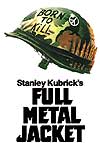 Full
Metal Jacket (1987) Full
Metal Jacket (1987)Starring: Matthew Modine, Adam Baldwin, Vincent D'Onofrio, R. Lee Ermey Director: Stanley Kubrick Stanley Kubrick's thought-provoking Vietnam War film was partly based on Gustav Hasford's 1979 book The Short Timers, and followed in the footsteps of Kubrick's other anti-war films: Paths of Glory (1957) and Dr. Strangelove, Or: (1964). This was Kubrick's first film after The Shining (1980), and it made an underappreciated appearance the year after Oliver Stone's Platoon (1986) won Best Picture. Kubrick's film was unsuccessful at the box office -- lost in the spate of mostly Vietnam-related war films that came out in Platoon's wake, including Heartbreak Ridge (1986) (about the invasion of Grenada), Hamburger Hill (1987), The Hanoi Hilton (1987), Casualties of War (1989), 84 Charlie Mopic (1989), and Born on the Fourth of July (1989). A two-part drama, the first part of the film takes place at Parris Island training-boot camp in S. Carolina (although the entire film was shot in England), where drill instructor Gunnery Sgt. Hartman (Ermey, a former, real life Marine sergeant) transforms young Marine cadets into killing machines with twisted sentiments, and verbal, psychological, and physical abuse and torment. The first half climaxes with a chilling, dehumanizing bathroom scene between Hartman, Private Leonard Lawrence (dubbed "Gomer Pyle") (D'Onofrio) - an overweight, misfit cadet driven insane by Hartman's bullying, and Private J.T. Davis (dubbed "Joker") (Modine), who is caught between them. "Joker," a cynical Stars & Stripes military correspondent/journalist, is the bridge to the second half of the film on the nightmarish, violent front lines within Hue City - a cool, unemotional look at urban warfare on the eve of the 1968 Tet Offensive at the turning point of the war. Academy Award Nominations: 1, Best Adapted Screenplay--Stanley Kubrick. |
G |
 Gaslight (1944)
Gaslight (1944)Starring: Charles Boyer, Ingrid Bergman, Joseph Cotten, Dame May Whitty, Angela Lansbury Director: George Cukor Aka The Murder in Thornton Square, this is a superb, definitive psychological suspense thriller from 'woman's director' George Cukor. [Previous Cukor films that were similar as period dramas included Little Women (1933), David Copperfield (1935), and Camille (1936).] This lavish and glossy MGM film, with authentic Victorian-era production design, was a remake of a taut and subtle film made five years earlier in Great Britain. This earlier version, starring a very sinister Anton Walbrook and Diana Wynyard, was directed by Thorold Dickinson and released in the US as both Gaslight and Angel Street (1940). Both versions were adapted from Patrick Hamilton's long-running, London staged play-melodrama, originally titled Angel Street. The film's plot, faithfully adapted by its screenwriters, is about a diabolical, Victorian criminal husband Gregory Anton (Boyer playing against type) who systematically and methodically attempts to torment and drive mad his bedeviled, shy young wife Paula Alquist (Bergman), while in pursuit of hidden jewels. Bergman was very effective in the role of the vulnerable woman, who becomes helpless as she experiences a debilitating nervous breakdown and near insanity, until saved by her romantic admirer - a suspicious Scotland Yard detective Brian Cameron (Cotten). The film's impressive photography is expressionistic, shadowy, and menacing - as befits the film's ominous plot. Academy Award Nominations: 7, including Best Picture, Best Actor--Charles Boyer, Best Supporting Actress--Angela Lansbury (in her film debut), Best Original Screenplay, Best Cinematography. Academy Awards: 2, Best Actress--Ingrid Bergman (with her first of three Oscars), Best B/W Art Direction/Interior Decoration. |
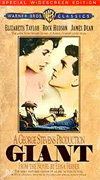 Giant (1956) Giant (1956)Starring: Rock Hudson, Elizabeth Taylor, Mercedes McCambridge, James Dean, Dennis Hopper, Mickey Simpson Director: George Stevens The sprawling, grandiose and iconic western epic and drama was based on the celebrated Edna Ferber novel about two generations of a wealthy American cattle ranching family spanning a twenty-five year period, who clashed over money, property, class differences, and racism in Texas (the film was shot on location in Marfa, TX). It was particularly poignant as the last (and 2nd posthumous Oscar-nominated) performance of James Dean’s tragically short career. In the film's opening set in the 1920s, newly-wed Maryland socialite belle Leslie Lynnton (Taylor), arrived with her new, wealthy Texas rancher-husband Jordan 'Bick' Benedict, Jr. (Hudson) at his sprawling Benedict Texas ranch (known as "Reata"). They met his older, tough, cattle-driving spinster-sister Luz Benedict (Mercedes McCambridge), who managed the ranch, and uneducated, laconic Texas ranch-hand cowboy Jett Rink (Dean), in an iconic pose - sitting in the back of a black convertible with his feet up during an outdoor BBQ. In a memorable scene, Rink was instantly made a tycoon millionaire when he struck oil on his own small piece of land (Little Reata). Covered with the gushing liquid black gold (crude oil), he made boastful, defiant and resentful statements to the Benedict family about how he would be richer than them, and made an inappropriate pass toward Leslie (the object of his unrequited love) - this established the origins of a fierce rivalry. Over the years, Rink aged from a young man to a mumbling outcast and dissolute drunkard (known as "Mr.Texas"), especially during the celebratory scene to commemorate the opening of his new airport and hotel in Hermosa, Texas. The lonely and pathetic Rink drunkenly sobbed in the empty banquet room, and rambled about his unrequited love for Leslie. In another memorable scene, Bick engaged in a fist-fight with Sarge (Simpson), the bigoted cafe owner of Sarge's Place who refused to serve an elderly Latino couple while "The Yellow Rose of Texas" blared on the jukebox. Academy Award Nominations: 10, including Best Picture, Best Actor (Dean), Best Actor (Hudson), Best Supporting Actress (McCambridge), Best Adapted Screenplay, Best Color Art Direction/Set Decoration, Best Color Costume Design, Best Film Editing, and Best Music Score (Dimitri Tiomkin). Academy Awards: 1, Best Director-George Stevens. |
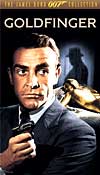 Goldfinger (1964) Goldfinger (1964)Starring: Sean Connery, Gert Frobe, Honor Blackman, Shirley Eaton, Tania Mallet, Harold Sakata Director: Guy Hamilton The third entry in the long-running series of Bond films and the first official blockbuster for the franchise. Considered by most viewers as the quintessential 'Bond' film that set many precedents and the formula for future 007 films, including: Sean Connery's definitive portrayal of the MI6 agent, Bond gadgets, iconic 'Bond Girls,' the theme song and pre-credits sequence, classic lines of dialogue, the Aston-Martin, great action sequences, etc. After an initial pre-credits sequence set at a Latin American drug lord's laboratory, Bond (Connery) was dispatched to investigate gold-obsessed bullion dealer-smuggler Auric Goldfinger (Frobe) staying at a Miami hotel. During an affair with Goldfinger's mistress Jill Masterson (Eaton) there, Bond was knocked unconscious by Goldfinger's mute Korean servant Oddjob (Sakata) with a lethal bowler hat, and in revenge, Masterson was asphyxiated to death by gold body paint. During Bond's pursuit of Goldfinger to Switzerland, Bond assisted Jill's vengeful sister Tilly (Mallet), but she also lost her life to Oddjob. Bond was captured and subjected to torture via a laser-beam directed at his crotch. Bond later pursued Goldfinger at his stud-horse ranch in Kentucky where he learned of Goldfinger's grand plot, known as "Operation Grand Slam," to infiltrate the US Depository at Fort Knox, contaminate the gold reserve with a dirty bomb, and disrupt the world's economy for personal gain. In the climactic scene at Ft. Knox, Pussy Galore's Flying Circus (five planes) took off and sprayed Delta 9 nerve gas over the Fort Knox area and the facility's troops to gain entry to the Depository, not realizing the canisters had been changed. A showdown occurred between Bond and Oddjob, both caught inside the sealed gold bullion vault as the nuclear bomb's timer ticked down. Bond cleverly electrocuted Oddjob and in the nick of time, the timer on the bomb was disarmed. Later, escaping villain Goldfinger hijacked Bond's private jet enroute to the White House, but suffered death when the plane decompressed by a shot fired from his golden gun, and he was sucked through a tiny window. Bond and sexy, lesbian-leaning, but converted private pilot Pussy Galore (Blackman) parachuted with Bond to safety onto a tropical island before being rescued by helicopter. Goldfinger was the first Bond film to win an Academy Award - its sole nomination for Best Sound Effects. |
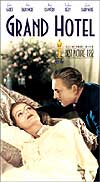 Grand Hotel (1932) Grand Hotel (1932)Starring: Greta Garbo, John Barrymore, Joan Crawford, Lionel Barrymore, Wallace Beery, Lewis Stone, Jean Hersholt Director: Edmund Goulding An MGM all-star classic film and soap opera that won the Best Picture Oscar - its sole nomination. It was the best example of an all-star production heavily bankrolled by the studios. The film set a pattern for future films (known as portmanteau - or anthology - films, centered around an event, person, or location), telling stories about the lives and destinies of several individuals. They included a vivacious office stenographer, a brusque unethical businessman, a ballerina dancer, a gentleman jewel-thief, and a lowly terminally-ill bookkeeper - that were woven together into a whole. In the story, World War I was over, and Berlin's beautiful, art-deco Grand Hotel was busy with the intersecting lives and destinies of its glamorous guests in a 24-48 hour period. The dramatic ensemble cast included a weary, unloved and lonely ballerina Grusinskaya (Garbo), a financially-destitute nobleman and jewel-thief Baron Felix von Gaigern (Barrymore) who she fell in love with, a sexy, on-the-make stenographer Flaemmchen (Crawford) who met a dying clerk Otto Kringelein (Lionel Barrymore) searching for a last fling, and crude industrialist Gen. Director Preysing (Beery) seeking a business merger to avoid financial catastrophe. It was famous for highlighting Garbo's oft-quoted line: "I want to be alone." With only one Academy Award nomination and win -- Best Picture. |
 The
Great Dictator (1940) The
Great Dictator (1940)Starring: Charlie Chaplin, Jack Oakie, Paulette Goddard, Reginald Gardiner Director: Charlie Chaplin In his first full "talkie" (in a film similar to the Marx Brothers' Duck Soup (1933)) and his most financially-successful film, Chaplin plays a dual role as: (1) Adenoid Hynkel, the great dictator of the film's title - the power-mad, despotic ruler and Fooey (Fuhrer) of the fictional European nation of Tomainia, and (2) an un-named, humble, amnesiac Jewish barber (with some resemblance to Chaplin's Little Tramp character who was retired at the end of Modern Times (1936)) who returns years after being a soldier in World War I to discover that his long-abandoned shop is now part of the Jewish ghetto, occupied by thuggish Aryan stormtroopers of the Double Cross (rather than a Nazi swastika). In the film's role-reversal conclusion, the Jewish barber is mistaken for the country's tyrannical dictator Hynkel, who is obviously a mocking satire of Adolf Hitler, complete with his squared-off mustache and Nazi-ish uniform. An additional burlesque portrait of Italy's tyrannical Benito Mussolini is in the character of Benzino Napaloni (Oakie), dictator of the rival country of Bacteria. The film's message was made even more powerful by the satire, making fun of their demagoguery, fascism and anti-Semitism. Chaplin's bold and controversial parody, with its social and political commentary, was banned in occupied Europe, South America and Ireland. Some believed that Chaplin was trivializing the Nazi's violent rise to power; however, the film had initially entered production when most Americans viewed Adolf Hitler as an ally (not an enemy), and were opposed to entering WWII. It was released before the United States' entry into World War II (in 1941) and before knowledge of the Holocaust. One of the film's most famous scenes is Hynkel playing with an inflated balloon-globe of Planet Earth in a graceful, ballet-like sequence; also the pudding-coin lottery scene, and the one of the barber shaving a customer in time to a radio broadcast of Brahms' Hungarian Dance No. 5. The most powerful moment is when the barber (appearing as Hynkel) delivers a six-minute impassioned monologue (often interpreted as Chaplin's own plea) at the end of the film for peace, hope, human rights, understanding and world tolerance. The film earned Chaplin three Oscar nominations. Academy Award Nominations: 5, including Best Picture, Best Actor--Charlie Chaplin, Best Supporting Actor--Jack Oakie, Best Screenplay--Charlie Chaplin, Best Score. |
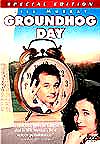 Groundhog
Day (1993) Groundhog
Day (1993)Starring: Bill Murray, Andie MacDowell, Chris Elliott, Stephen Tobolowsky Director: Harold Ramis Self-centered, pompous and cynical Pittsburgh weatherman Phil Connors (Murray) is forced to repeat his most unfavorite day, Groundhog Day (February 2nd), over and over again in this hysterically-funny, allegorical romantic fantasy-comedy. His assignment, for the sixth year, is to cover the famous Punxsutawney (PA) Phil -- the "official" groundhog -- a furry animal that predicts if Spring will have to wait another six weeks if it sees its own shadow. The thought-provoking story line by co-scriptwriter Danny Rubin, a meaningful existential thesis, was more or less a version of the Oscar-nominated, live-action short film 12:01 PM (1990) by Jonathan Heap, which was later expanded into a feature-length, science-fiction TV film titled 12:01 (1993), directed by Jack Sholder. The exact reason for the countless time-warp loop is never explained as the same day endlessly repeats itself, not even interrupted by Connors' numerous deaths and suicide attempts. As an Everyman stuck in repeating time, Phil's reaction to his situation moves from disbelief and denial, to annoyance and then anger, to chicanery and lustfulness, to despair and depression, and then to bargaining and finally to acceptance and philanthropy, as exemplified by his repeated dealings with the supremely annoying insurance salesman named "Needlenose" Ned Ryerson (Tobolowsky). Perhaps Murray's own Phil must remove the shadow from his own life, change his behavior, and become a better person before he can continue it. His relentless deja-vu experiences gradually change him from a grouch to a decent human being. Perhaps his life's wake-up call and endless reincarnations assist him in perfectly winning the heart of beautiful TV producer Rita (MacDowell). The comedy was part of a series of Bill Murray-starring comedies in the early 1990's, including Quick Change (1990) (which he also co-directed), Frank Oz' What About Bob? (1991), and Mad Dog and Glory (1993). Groundhog Day had fair box-office business and earned good reviews, but was completely overlooked by the Academy. No Academy Award Nominations. |
H |
 Halloween
(1978) Halloween
(1978)Starring: Donald Pleasence, Jamie Lee Curtis Director: John Carpenter A genuinely scary, stylistic and tasteful, extremely well-crafted slasher/horror classic from young film director/writer John Carpenter, with the tagline: "The Night HE Came Home!" The efficiently-suspenseful, surprise hit film, with a jarring musical theme, grossed over $60 million - and became one of the most successful independent films ever made. This PG-rated, low-budget film (filmed in only twenty days) invented many of the "slasher" film cliches (along with its predecessors: George A. Romero's Night of the Living Dead (1968), the big-budget The Exorcist (1973), and Tobe Hooper's The Texas Chainsaw Massacre (1974)), but also paid homage to Alfred Hitchcock's Psycho (1960) in the initial murder of the film. The film told about a psychotic, criminally-insane murderer, Michael Myers, who was on a homicidal rampage after escape from an institution, and on Halloween night terrorized his hometown of Haddonfield, Illinois. It also launched the career of Jamie Lee Curtis (dubbed the "Scream Queen") in her film debut, as resourceful, teenaged baby-sitter Laurie who is terrorized in a house, and starred Donald Pleasence as the obsessed psychiatrist Dr. Sam Loomis (the name of the boyfriend character in Psycho (1960)) in pursuit. Unfortunately, the serial killer slasher film spawned many run-of-the-mill inferior sequels of its own, and other imitation films (When a Stranger Calls (1979), Don't Go In The House (1980), Friday the 13th (1980) and its numerous sequels, He Knows You're Alone (1980), Prom Night (1980), Graduation Day (1981) and Happy Birthday to Me (1981), and more with the character names of Jason and Freddy). No Academy Award Nominations. |
 Hannah
and Her Sisters (1986) Hannah
and Her Sisters (1986)Starring: Barbara Hershey, Michael Caine, Mia Farrow, Dianne Wiest, Maureen O'Sullivan, Lloyd Nolan, Max Von Sydow, Woody Allen, Carrie Fisher, Julie Kavner Director: Woody Allen Woody Allen's masterful, insightful comedy/drama about contemporary New Yorkers. This episodic film is full of vignettes woven together, and features some of the sharpest direction and writing of Allen's career. The threaded-together, multiple storylines, very typical of an ensemble film, focus on the lives of three sisters during a traditional Thanksgiving dinner gathering: the eldest sister - homemaker and 'matriarch' Hannah (Farrow), the neurotic middle sister - actress Holly (Wiest in an Oscar-winning performance), and the emotional, free-spirited Lee (Hershey), and their relationships in mid-life crisis. There are other fully-developed characters all playing out their neuroses and lives: Hannah's ex-husband Mickey (Allen) who has a despairing obsession with death, illness, and unhappiness; older and cynical Soho artist Frederick (Von Sydow) who lives with Lee; Hannah's adulterous, financial accountant husband Elliot (Caine, also in an Oscar-winning role), who has a torrid but shallow love affair with Lee behind Hannah's and Frederick's backs; and Holly's desperate struggle to prove herself to the world. Even the peripheral characters are believable: the sisters' embittered show business parents (O'Sullivan and Nolan), Holly's best friend and rival April (Fisher), as well as Mickey's assistant and voice of reason Gail (Kavner). Although considered by some to be Allen's best work, it lost to Oliver Stone's Platoon (1986) for Best Picture. Academy Award Nominations: 7, including Best Picture, Best Director--Woody Allen, Best Film Editing, Best Art Direction/Set Decoration. Academy Awards: 3, including Best Supporting Actor--Michael Caine, Best Supporting Actress--Dianne Wiest, Best Original Screenplay--Woody Allen. |